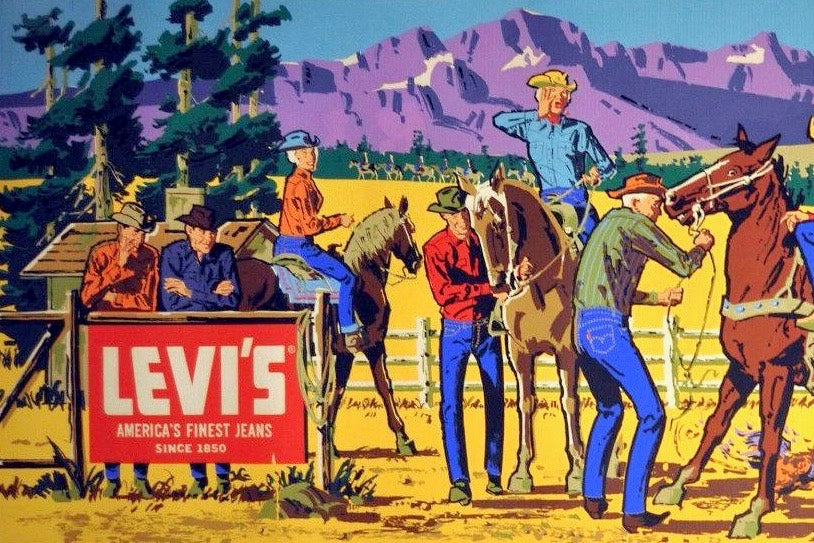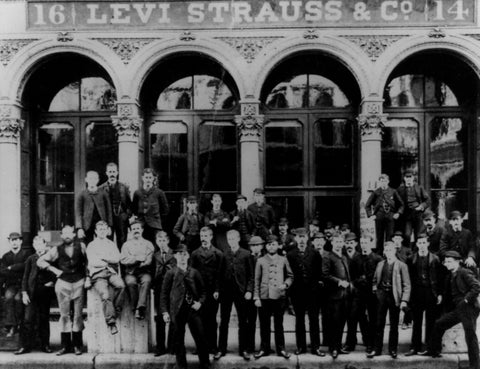
Brand History - Levi's
When Levi Strauss from Bavaria opened a dry goods company in San Francisco in 1853, the California Gold Rush was in full effect. Strauss' goal was to serve the small general stores of the American West, but what he actually accomplished was to be much bigger than that. But before we come to the legendary 501 jeans and the Type I-III denim jackets, we need to look at how it even came to this point and how the idea of the first jeans was even conceived.


With his dry goods company, Strauss was supplying Jacob Davis, a Latvian born tailor with fabrics such as cotton duck cloth or denim cotton for his tailor shop in Reno, Nevada. In 1870, a woman ordered a special pair of trousers for her husband who was a woodcutter. Davis created a strong and durable pair of working pants out of duck cloth and he reinforced seams and pockets with copper rivets. Later he would also use denim to produce the pants as word about his work spread rapidly through word-of-mouth. Demand rose so quickly that Davis could not keep up with the demand.

So, one day Davis approached Strauss and asked for financial backing for the filing of a patent for his reinforced jeans. Strauss was convinced by the idea because he already recognized what the hard workers of their time needed - durable and reliable clothing. They then received as U.S. patent for an "Improvement in Fastening Pocket-Openings" in 1873. During this time, Strauss had set up a tailor shop for the production of the working pants in San Francisco. Davis ran this shop, which would become the birth place of the legendary 501 Levi's denims, distinguished in part by its five pockets. That is also why the pants are often called "five pocket jeans".
It has always been important for the Levi's brand to differentiate itself from competitors' products and imitators. Thus, in 1886, the iconic and still used Two Horse Trademark was introduced to highlight the durability of the pants. The logo shows two horses trying (in vain) to tear apart a pair of Levi's. In addition, the legendary red tab was applied to the right back pocket of 501 jeans for the first time in 1936 to distinguish Levi's pants from the competition.

But when we think of Levi's these days, most people think not only of denim jeans, but also of denim jackets. In 1905, Levi Strass launched the Levi Blouse with the code 506. It was made of the same denim as the legendary blue jeans and was meant to be its companion to represent an entire denim set. The design was kept rather simple. It had a boxy fit and was rather short to offer as much freedom of movement as possible. On the front was a large chest pocket and the back had a back strap to adjust the size. Like the pants, the Levis Blouse received the famous red tab for the first time in 1936. The title was then changed from "Blouse" to "Jacket" in 1938, but the piece was already called Number One in 1917, hence the familiar name "Type I". Over the years, the Type I was slightly revised again and again and a few details were adjusted. Thus, there were a total of 6 versions of the jacket which differed only slightly from each other - the basic structure remained the same. The jacket quickly gained popularity and was worn not only by workers, but also by famous people of the time.

In 1953, the successor was introduced - the 507XX jacket, or Type II. The Type II kept most of the general shape of the Type I, but it was slightly longer, had a second chest pocket and changed the back strap for a waist adjuster with buttons. The Type II became the symbol of youth subcultures and the rock and roll scene. But compared to the Type I and the yet to be released Type III, the Type II had a rather shorter lifespan of only 9 years until 1962. But this short period of production only further strengthened the cult factor of the Type II and so an original Type II jacket from this period can be worth quite a bit, especially for collectors.

The successor was not long in coming, and so in the same year the 557 jacket, or Type III, came into the stores. And if the Type I and II did not already ensure that the denim jacket received a legendary status, it was a the latest with the Type III at the time. The chest pockets were made a little smaller and set higher. The overall fit became slightly narrower and two V-seams ran from the chest pockets to the hem, which gave the jacket a high recognition value. In 1967, the jacket was given the new code 70505, under which it is still known today. In 1980 the two side pockets were added. The Type III is what we understand today as a typical trucker jacket. It also found its way into the many rebellious subcultures of the youth, especially in the grunge scene of the 90s - so you could see Kurt Cobain regularly in a denim jacket.

The special thing about Levi's denim jeans and jackets is that they managed to outgrow the pure work context and became a key-piece of modern fashion. They evolved from a product for 19th century American workers to a timeless fashion piece with great cultural relevance. Levi's also made the transition into the new millennium. This can be seen above all in the early 2000s when denim experienced a major "revival". When the words "2000s" and "denim" are mentioned, many immediately think of the iconic picture of Britney Spears and Justin Timberlake from the 2001 American Music Awards. Denim from head to toe, literally, because even JT's hat was made of the material.

Like many fashion brands today, Levi's has also launched several collaborations. For example, the brand has already worked together with New Balance, UNDERCOVER, Human Made or Supreme.
If you want to own a piece of Levi's history, check out our full selection of vintage Levi's pieces here! We also have a larger selection of vintage Levi's pants in our Mannheim store, so it's worth stopping by!